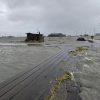Queensland is grappling with the aftermath of severe storms and flash floods that have claimed seven lives since Christmas. The region, now facing extreme heat, is also dealing with widespread power outages.
Over 120,000 homes and businesses were affected by the storms, which brought heavy rain, lightning, and strong winds. As of Thursday, more than 43,000 people were still without power, although efforts are underway to restore electricity to the majority of affected areas.
Federal Emergency Management Minister Murray Watt has urged residents to help vulnerable neighbors, particularly the elderly and disabled.
He recommended using fans or air conditioning if available and seeking refuge in public spaces like libraries or pools if power is out.

The Queensland energy minister, Mick de Brenni, stated that by December 30, 80% of affected properties should have power restored, with 90% expected by New Year’s Eve.
Health Minister Shannon Fentiman expressed concern over the combination of heat and power outages, advising people to use cold towels and visit air-conditioned public places to avoid heat stress.
The Gold Coast, heavily damaged with 400 homes affected, is receiving support from volunteers across Queensland and northern NSW.
Public pools on the Gold Coast will be open and free to use during the heatwave, but residents are advised to avoid swimming in natural water bodies until they have been tested. The Queensland ambulance service has reported an increase in emergency calls due to both the storms and the heat.
In response to the disaster, the government has activated assistance packages, offering emergency grants and support for repairing essential services. Uninsured residents can receive substantial grants to replace damaged household items and restore essential utilities.

